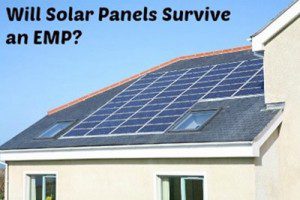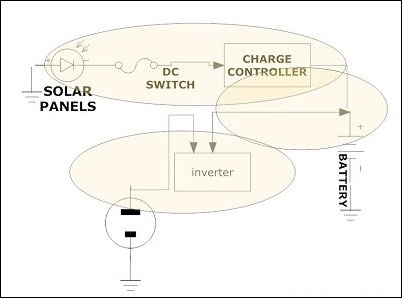By Gaye Levy
Contributing Writer for Wake Up World
When in comes to all things solar, I am a novice. I have a very basic set-up from Harbor Freight that is used for light duty power in my garage, but other than that, I have a long way to go. So when I was asked the question “Will solar panels survive an EMP?” – I was stumped.
First of all, no one really knows what will or will not survive a massive electromagnetic pulse such as the type in the hugely popular book One Second After.
Second, and more to the point, I am not well versed on the technical side of electronics even though I am a techy nerdy type when in comes to computers.
Faced with a good question and no answer, I turned to my long time friend, George Ure, who I have known since 1971. George writes a popular news and economics column at UrbanSurvival.com is the author of Peoplenomics. He is an absolute whiz at this stuff so I turned the question over to him.
George Ure on Solar Panels and EMPs
“The answer to EMP protection is fairly complex, as you might imagine.
[pro_ad_display_adzone id=”110028″]
EMP is a pulse of energy created by an atomic or chemical blast under highly specialized conditions. The easiest way to create it is to set off a fairly high yield atomic blast above the Earth’s atmosphere. Gamma radiation, upon striking the upper atmosphere, sets off the pulse which is about one-third the length (or smaller) than the duration of a lightning strike.
In the analysis of EMP damage, one needs to look not only at the device itself (the solar panel) but you also need to take into account the peripheral equipment and wiring. A solar panel itself may be inherently resistant to EMP to some extent. But, if damage occurs, it is likely due to the wires between the solar panel and (most often) the solar charge controller.
Another way of looking at it is to pretend that the system you are trying to protect is a complex network of components that might (in simplest form) look like this:
I’ve drawn three transparent areas to represent the three “antennas” that are commonly created by this kind of installation:
· Upper left: Solar panel to battery including the wire run from the panels, DC disconnect switch, wiring to the charger controller.
· Right: Wiring from the charge controller to the battery.
· Lower left: From the battery to the inverters (which turns the DC into useful AC power) and the inverter output wiring.
I have a fairly extensive grid-interactive system so I’ve installed multiple layers of protection. On the panel side I have transient voltage suppressors (TVSs) from the panels to ground. Next there is a network of TVS (actually 5 discrete devices wired in parallel across the battery bank) and then a serious (4,000 joule) line surge device on the inverter’s AC side.
Now, as to what’s going to “give” first (in the event of an actual emergency, eh?) that becomes anyone’s guess. What I can tell you is that lightning plays havoc (and is a very likely enemy of any off-grid installation, particularly in the South during spring tornado and thunderstorms).
About a year ago we had a serious lightning strike about 500-feet from our solar panels. The panels did just fine. What blew out was the AC grid-interactive control circuitry which is how I spent $1,200 to learn that my fancy inverter-chargers, while great in general (Outback power GTFX 2524’s stacked) they were no match for a surge of many hundreds of volts coming directly over from our neighbor’s house which takes off from the same power pole transformer.
You talk about turning ol’ George into a True Believer in the best surge protection you can afford! Making a major commitment to solar and keeping it online during [whatever] involves a number of subtle design attributes and your readers are wise to think of these up front.
If you’re looking at a couple of discrete panels and a small $200-class inverter and a few car batteries? Simply keep the charge controller in your metal (Faraday cage) garbage can and short the solar panel leads (not in bright sun, of course!) and don’t worry.”
The Final Word
As I said at the onset, no one really knows what will happen if there is a catastrophic EMP. George’s answer is to get the best surge protection possible and don’t worry. Actually, when you think about it, if a huge EMP was going to take down the grid, we would have a lot more to worry about than our home-based solar setup.
Just thinking about it makes me want to eat chocolate.
Enjoy your next adventure through common sense and thoughtful preparation!
Gaye
Further articles by Gaye Levy:
- Nifty Things Your Grandmother Knew
- Cooking Lessons from the Great Depression
- Six Ways to Get Ready for Going Off-Grid
- DIY Miracle Healing Salve
- The Powerful Healing Qualities of Rosemary Essential Oil
- 15 Alternative Uses for Honey
- Vermiculture: How To Build A Worm Bin the Cheap and Easy Way
- Spices for the Survival Pantry
- 21 Home Remedies for a Toothache Emergency
- The Miracle of Tea Tree Oil: 80 Amazing Uses for Survival
- 10 Simple Steps Toward Self-Sufficiency
- Creating a Healing Garden: 9 Healing Herbs You Can Grow Yourself
About the author:
 Gaye Levy, also known as the Survival Woman, grew up and attended school in the Greater Seattle area. After spending many years as an executive in the software industry, she started a specialized accounting practice offering contract CFO work to emerging high tech and service industries. She has now abandoned city life and has moved to a serenely beautiful rural area on an island in NW Washington State.
Gaye Levy, also known as the Survival Woman, grew up and attended school in the Greater Seattle area. After spending many years as an executive in the software industry, she started a specialized accounting practice offering contract CFO work to emerging high tech and service industries. She has now abandoned city life and has moved to a serenely beautiful rural area on an island in NW Washington State.
Gaye lives and teaches the principles of a sustainable and self-reliant lifestyle through her website at BackdoorSurvival.com. At Backdoor Survival, she speaks her mind and delivers her message of prepping with optimism and grace, regardless of the uncertain times and mayhem swirling around us. You can find Gaye through her website BackdoorSurvival.com, on Facebook, Twitter and Pinterest.
If you have not done so already, please be sure to like Gaye’s Facebook page, which is updated every time there is an awesome new article, news byte, or link to a free survival, prepping or homesteading book on Amazon. In addition, when you sign up to receive Gaye’s email updates you will receive a free, downloadable copy of her e-book The Emergency Food Buyer’s Guide.
[pro_ad_display_adzone id=”110027″]








